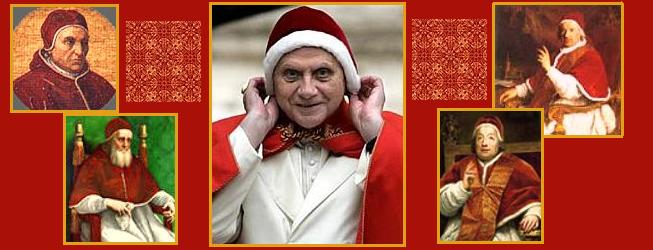The camauro appears in the portraits of popes before the Reformation. Its revival for a single occasion by Pope Benedict XVI was surely within his well-known program of the “hermeneutic of continuity.”
From left to right: Pope Innocent VII (1404-1406), Pope Julius II (1505-1513),
Pope Benedict XVI (2005-2013), Pope Clement XII (1758-1769), Pope Benedict XIV (1740-1758).
In her provocative book, “The Rite of Sodomy” (New Engel Publishing, 2006), author Randy Engel wrote of the camauro, worn for centuries by the popes in Rome, “During Christmas 2005, the pope was photographed showing off a red medieval fur-lined hat—a picture that can only be described as overtly camp” (p. 1171). There is a different and better explanation.
Engel reveals a lack of knowledge of church history. She should have written instead that it is “overtly papal.” The camauro appears in the portraits of popes before the Reformation. Its revival for a single occasion by Pope Benedict XVI was surely within his well-known program of the “hermeneutic of continuity.” He insisted that there was no break with tradition, and that the Second Vatican Council was misunderstood if it is portrayed in terms of a “hermeneutic of rupture.” Any symbolic union with the past is a way of emphasizing continuity with our past, as Russell Shaw indicated in “Continuity and Change” (InsideCatholic.com, 25 March 2011).
To this end, Benedict revived the processional cross-staff of Pope Pius IX, the wider use of Latin in St. Peter’s for the sacred liturgy, kneeling to receive Holy Communion on the tongue, and other specific symbolic choices which predated the 1962-1965 council. Obviously, Engel published her study before the motu proprio of August 2007, which restored the Roman Missal of 1962. Likewise, she wrote before the May 13, 2011 Instruction, Universae Ecclesiae.
Paul Zalonski wrote this about Pope Benedict:
Perhaps the most apparent and luxurious sign of the new era is the pope’s vestments. Benedict has worn an ancient form of the pallium, or cloak, preferred by first-millennium pontiffs. He also brought back the ermine-trimmed red satin mozzetta, a short cape. And the pope clearly does not obey the article of American political faith never to don an unconventional cap. He has sported a red saturno, a sort of papal cowboy hat, and an ermine-trimmed camauro, a crimson cap that resembles a Santa hat, and is worn on non-liturgical occasions.
http://communio.stblogs.org/2010/12/beautiful-liturgy-is-hard-work.html
Was it not Sigmund Freud who said that “sometimes a cigar is just a cigar”? Ms. Engel is naively American in her political faith and just too untraditional in her statement that the camauro is merely “camp.”
For all we knew, the pope’s personal physician may have ordered the elderly Benedict to wear a hat outdoors, and for a pope, there is no real choice except the historic camauro which is simply the pontifical biretta. John Allen (online National Catholic Reporter, 21 November 2010) wrote that in December 2005, Benedict XVI once sported the camauro, a thick woolen cap last worn by Pope John XXIII. Several commentators touted it as an example of Benedict’s traditionalism. But in the Peter Seewald interview, the pope says the reality was far more prosaic: It was a cold day, Benedict has a cold-sensitive head, the camauro was lying around, and he simply put it on. Benedict said he’s never done so since, “in order to forestall over-interpretation.”
It remains to be seen whether the new pope elected in 2013 will do as Pope Benedict did in reviving the limited use of the camauro.
Camauro Etymology
Latin: camelaucum, from the Greek kamelauchion = camel skin hat. A cap traditionally worn by the pope. Camauros are red with white ermine trim, and are worn in place of the biretta of lower orders of clergy. The camauro is thought to represent the headgear of the “armor of God.” It has been part of the papal wardrobe since the 12th century. For a while, it was worn by cardinals, though without the ermine trim, but in 1464 it was restricted to the pope with cardinals wearing the scarlet zucchetto instead. The papal camauro fell into disuse after the death of Pope John XXIII in 1963, but Pope Benedict XVI wore one in December 2005.

A reader asked about the tiara, so ceremoniously surrendered by Pope Paul VI. I do not think any significant symbol should be discarded permanently. The tiara could be re-interpreted as a sign of trinitarian faith in a religious world increasingly hostile to the doctrine of the Blessed Trinity. This would then accord with the tiara depicted in the long history of Catholic art. The art works of the past need not slide into obscurity. They should not seem foreign to our youth.